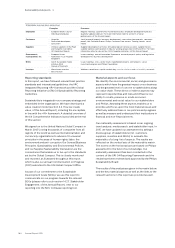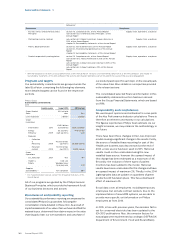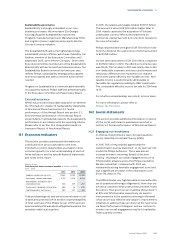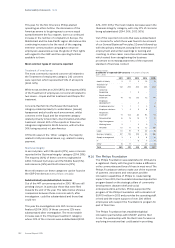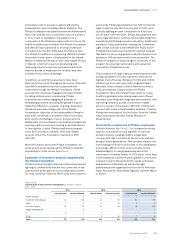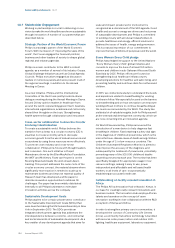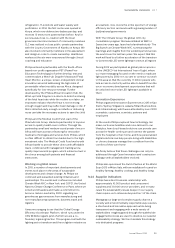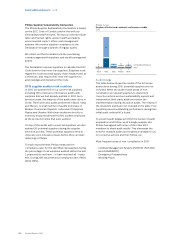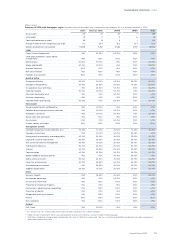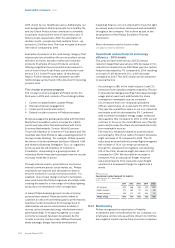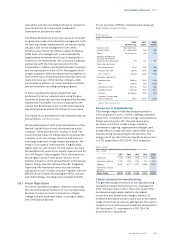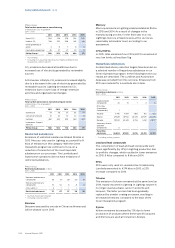Philips 2015 Annual Report Download - page 194
Download and view the complete annual report
Please find page 194 of the 2015 Philips annual report below. You can navigate through the pages in the report by either clicking on the pages listed below, or by using the keyword search tool below to find specific information within the annual report.Sustainability statements 14.2.7
194 Annual Report 2015
14.2.7 Stakeholder Engagement
Working in partnerships is crucial in delivering on our
vision to make the world healthier and more sustainable
through innovation. A number of our partnerships are
described below.
Strategic Partner of the World Economic Forum
Philips is a strategic partner of the World Economic
Forum. With its mission of “improving the state of the
world”, the Forum engages the foremost political,
business and other leaders of society to shape global,
regional and industry agendas.
Philips is a main contributor to the WEF’s content
agenda, as a member of several of its Industry Groups,
Global Challenge Initiatives as well as Global Agenda
Councils. Philips executives engaged as discussion
leaders in numerous panels and were present in all of
the regional meetings, in addition to the Annual
Meeting in Davos.
As a new initiative, Philips and the International
Committee of the Red Cross jointly hosted a dinner
dialogue meeting during the Annual Meeting in Davos.
Around 20 key opinion leaders in healthcare from
around the world, representing government, business,
international organizations, academia and civil society,
shared their thoughts on the topic ‘Strengthening
health systems through collaboration and innovation’.
Cross-sector collaboration to drive the Circular
Economy transformation
To create a sustainable world, Philips believes the
transition from a linear to a circular economy (CE) is
essential. A circular economy aims to decouple
economic growth from the use of natural resources and
ecosystems by using those resources more eectively.
To promote cross-industry and cross-sector
collaboration, Philips joins forces with thought leaders
and conveners. One such initiative is Project
Mainstream, driven by the Ellen MacArthur Foundation,
the WEF and McKinsey. Frans van Houten is on the
Steering Board and leads the work stream Asset-
tracking. This project addresses the outer circle of the
circular economy concept, the material streams where
signicantly more traction is needed to scale up to
mainstream business and improve material quality. A
Research team has developed a white paper to
describe innovation opportunities to address CE
challenges. The paper has been widely distributed
internally to all Philips businesses to stimulate
innovation activities across the company.
Sustainable Development Goals
Philips aspires to be a major private sector contributor
to the Sustainable Development Goals (SDGs) that
were launched during the UN General Assembly in New
York in September 2015. The SDGs provide an
integrated development agenda that addresses the
interdependence between economic, environmental
and social elements of sustainable development. As a
key enabler of any development agenda that aims for
scale and impact, private sector involvement is
recognized as a vital element of the SDG agenda. Good
health and access to energy are drivers and outcomes
of sustainable development and Philips is committed
to working closely with all relevant stakeholders to
provide healthcare and energy-ecient solutions to
address the issues of health, energy and governance.
This is a natural expression of our commitment to
improve the lives of billions of people around the world.
Every Woman Every Child pledge
Philips has pledged its support to the United Nations’
“Every Woman, Every Child” global initiative and
commits to improve the lives of at least 100 million
women and children in sub-Saharan Africa and South
East Asia by 2025. Philips’ eorts are focused on
strengthening local healthcare infrastructures,
developing solutions for healthier and safer living, and
promoting healthy and nutritious diets for mothers and
children.
In 2015, we conducted a study to understand the needs
and aspirations related to breastfeeding for working
mothers in Africa. We especially focused on the barriers
to breastfeeding and on how innovation can empower
working African mothers to continue breastfeeding at
the levels recommended by the WHO. The study has
yielded a lot of valuable insights, both for Philips as well
as the international development community, which we
are now converting into an innovation agenda.
On World Pneumonia Day, Philips announced the
introduction of a new device to help diagnose fast
breathing in children. Fast breathing is a key vital sign
in the diagnosis of childhood pneumonia, which is the
main infectious-disease cause of death among children
under the age of 5, in low-resource countries. The
Children’s Automated Respiration Monitor is aimed to
help improve the accuracy of the diagnosis, and
subsequently the treatment of pneumonia, potentially
preventing many of the 935,000 childhood deaths
caused by pneumonia each year. The monitor has been
specically designed for appropriate usage in low
resource settings, making it easy to use, power
independent and aordable and will assist health
workers, in all levels of care, in automatically
establishing an accurate breath rate.
Collaborating on locally relevant innovation in
Africa
The Philips Africa Innovation Hub in Nairobi, Kenya, is
our base for creating locally relevant innovations and
business models. The Innovation Hub employs African
talents and operates on the concept of open
innovation, working in close collaboration with the R&D
ecosystem of Kenya and Africa.
In order to strengthen primary care in communities, it
developed the concept of Community Life Centers
(CLCs), a community hub where technology is bundled
with services: solar power, indoor and outdoor LED-
lighting, healthcare equipment, laboratory equipment,


